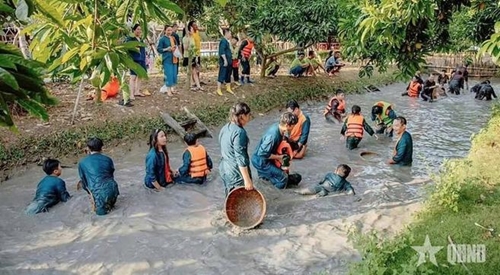Lack of regional coordination
Each locality in the Mekong Delta offers unique attractions. Can Tho is famous for the Cai Rang Floating Market and Ninh Kieu Wharf; Dong Thap boasts vast fruit orchards; and An Giang is known for spiritual sites like the Seven Mountains region and Ba Chua Xu Temple. However, the tourism experience is fragmented, with little coordination between provinces. Visitors often experience similar destinations without the variety that could make the region stand out.
    |
 |
|
Tourists enjoying entertainment activities in the Mekong Delta region (Photo: qdnd.vn) |
During interviews with tourists at Ninh Kieu Wharf over the April-May holidays, 76% of visitors described the Mekong Delta’s destinations as “beautiful but similar,” citing a lack of innovation.
Le Minh Trang from Da Nang said that she visited the Mekong Delta several times, and it seems repetitive, boats, traditional music, fruit gardens. “It’s beautiful, but there aren’t many new experiences,” Trang said.
Nguyen Thi Mai Lan from Hanoi added that moving between tourist sites is challenging. “The roads are narrow, and inter-provincial transport isn’t well integrated. Better transport and accommodation would improve my trip.”
Even international tourists face challenges. Dan Morgan, an Australian visitor at the Mekong Delta Eco Resort in Can Tho, praised the region’s beauty but lamented the lack of English-language information and a cumbersome booking process. He said he hopes for more professional development in the local tourism sector.
Local traders also noted the lack of inter-provincial tourism connections. Tran Thi Hong, a vendor at Ninh Kieu, said tourists often visit only one province, making trade unpredictable. Nguyen Van Tam, from a Can Tho travel agency, explained that creating inter-provincial tours is difficult due to inconsistent regulations and a lack of cooperation.
This fragmentation leads to a lack of cohesive tourism products. Infrastructure, especially water transport and digital tourism services, remain underdeveloped. To unlock the Mekong Delta’s potential, stronger regional cooperation and improved infrastructure are essential.
Administrative unit reorganization: New direction for regional tourism
To improve management, the Government has merged administrative units in the Mekong Delta. The region now encompasses five provinces, namely Tay Ninh, Vinh Long, Dong Thap, Ca Mau, and An Giang, and Can Tho city. This restructuring is seen as a step towards better resource consolidation and collaboration, laying the groundwork for more professional tourism development.
Tran Viet Phuong, President of the Mekong Delta Tourism Association, emphasized that streamlining is crucial for reorganizing tourism. With reduced administrative units, provinces can cooperate on cross-regional tourism projects, creating a more integrated experience.
    |
 |
|
Mekong Delta is a popular tourist destination thanks to its richness in cultural and natural resources. (Source: qdnd.vn) |
The restructuring has clarified regional strengths, he said. Can Tho, as the central hub, leads in tourism, especially after incorporating Soc Trang and Hau Giang, known for community-based tourism and Khmer festivals.
Ca Mau, merged with Bac Lieu, has eco-tourism potential with its mangrove forests and coastal renewable energy projects. Meanwhile, Dong Thap, formed from Tien Giang and Dong Thap, is famous for eco-tourism, fruit orchards, and destinations like Tram Chim and Sa Dec. An Giang, now including Phu Quoc, focuses on beach, island, and spiritual tourism.
This clearer division of strengths allows each province to focus on its unique offerings and fosters structured tourism development, Phuong commented.
In 2024, the Mekong Delta saw over 52 million visitors, a 15.9% increase from 2023, with international arrivals up by 49% to more than 2.8 million. Tourism revenue surpassed 62 trillion VND, up 36% from the previous year. These figures highlight the region’s potential, but experts agree that more investment in unique tourism products, clear brand identities, and revitalized marketing strategies is needed.
Nguyen Vu Khac Huy, Vice Chairman of the An Giang Tourism Association, pointed out that while the Mekong Delta’s cultural appeal is strong, tourism offerings remain basic. He suggested focusing on thematic tours that highlight history, culture, and literature. River-based tourism, including luxury river cruises and overnight boat trips, could extend stays and boost spending.
For sustainable growth, he said, key measures must be implemented, including improved infrastructure focused on waterway transport, advancing digital technology to enhance visitor experiences, raising the quality of human resources, and supporting local communities in preserving their cultural values.
Additionally, strengthening regional cooperation through joint councils and shared information systems is crucial. This will create a unified approach to tourism development and ensure long-term growth.
Streamlining the administrative structure in the Mekong Delta is a strategic effort to enhance tourism management. With improved cooperation between local authorities, the region has the potential to attract both domestic and international visitors, elevating its status within Vietnam and positioning it on the global tourism map.
Source: VNA